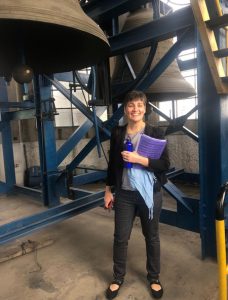
many ways to “let go” during her time as a
Knight-Wallace Fellow. In addition to the
U of M carillon, she also had the chance to
play on the largest carillon in Central and
South America on the class’ international
news trip to São Paulo.
A hand-lettered sign in a neighborhood coffee shop greeted
me with a bit of wisdom on my first morning in Ann Arbor: “Sometimes you just have to let go and see what happens.” If there ever was a time to let go, this was it. The academic year was about to start, and I had an ambitious study plan for the fellowship – creating high impact news products and best practices for workflow in product design. But I still hadn’t figured out how I would approach the challenge in the classroom.
I’d already combed through the 464 pages of the fall course catalog, searching for classes to teach me how other industries were using processes, systems and technology to transform their work. With so much to choose from, I wasn’t worried about filling a schedule. I knew I would find something that aligned with my study plan. After all I had a ‘short’ list of roughly 25 classes. (OK, I might have been trying too hard.)
The problem was my fear of not finding the right classes, of missing out on something or somehow not getting enough out of my precious time on campus. Could I follow the sign’s advice and just let go? It didn’t take long to find out.
At our very first orientation meeting, I spotted a poster on the way to tour Burton Memorial Tower: “Bells on the brain? Take Carillon 150. Play the U-M bell towers!”
The University of Michigan has two carillons out of only 600 in the world, one in the middle of Central Campus in Burton Tower and one in the Ann & Robert H. Lurie Tower on North Campus. And heck yeah, I wanted to play them.
The other students – a mix of about 20 graduate and undergraduate students – weren’t just music majors. They were studying everything from engineering and public health to community action and social change. We all had some kind of music training or background before signing up for carillon.
All the years of piano lessons and band had set me up for this opportunity, but the carillon required learning new techniques, like coordinating hands and feet, and setting aside time to experiment with new sounds and strengthen new skills.
Once I started spending time in the carillon practice rooms, I realized I had forgotten what it was like to learn something new – to have a beginner’s mind. It was fun. It was humbling and frustrating at times. It was also unexpectedly restorative.
Taking that first leap into the carillon class gave me the courage to try several other seemingly risky classes. I joined a team of mechanical engineering and design science students in a class in which we had to take a physical product from idea to prototype to verification through a series of analytical design processes. It was a crash course in engineering analysis and creativity and also design, psychology, marketing and economics. I learned quantitative methods for idea generation and selection, evaluating designs and anticipating failure modes in designs. In the process of applying those models to my team’s project, I gained new frameworks for thinking about how to create stories and news products.
I took a course where I learned about electronic health records systems and public health records, and the issues surrounding deployment and development of health technology. I have a new appreciation for the planning that goes into software rollouts, launches and upgrades having heard from professionals who manage technology that provides critical care for human beings.
By the time winter semester started, I was ready for more challenges. Someone recommended a course that was an introduction to rocket science.
That’s right, rocket science! Rocket Science might seem like an unusual choice for a journalist, but its language permeates the way our technology –oriented culture describes product development and innovation work: moonshots, launches, missions. And it encapsulated everything that I aimed for as a Fellow – to stretch and reach for new discoveries. To understand more fully why journalism is the work I had devoted my career to, to embrace others who are on the same mission and lift them up, too.
Oh, yeah, and to have a little fun.
The time in practice rooms, in classes, and with other Fellows and my family helped me start letting go of old patterns and routines. Learning a new instrument – or new technology – or taking on a new role requires practicing, stretching into a new repertoire and strengthening new skills.
Now that our time together in Michigan has ended, I think I’ve found the secret equation to the fellowship. It isn’t really about any one class or the specifics of the study plan. It’s about escaping the atmospheric distortion of the day-to-day journalism grind so you can see in different ways and explore new possibilities with a little less gravity. I’m excited to keep exploring – to let go and see what happens.
Sharilyn Hufford ‘19 is Deputy Editor, Platforms, for The New York Times.
